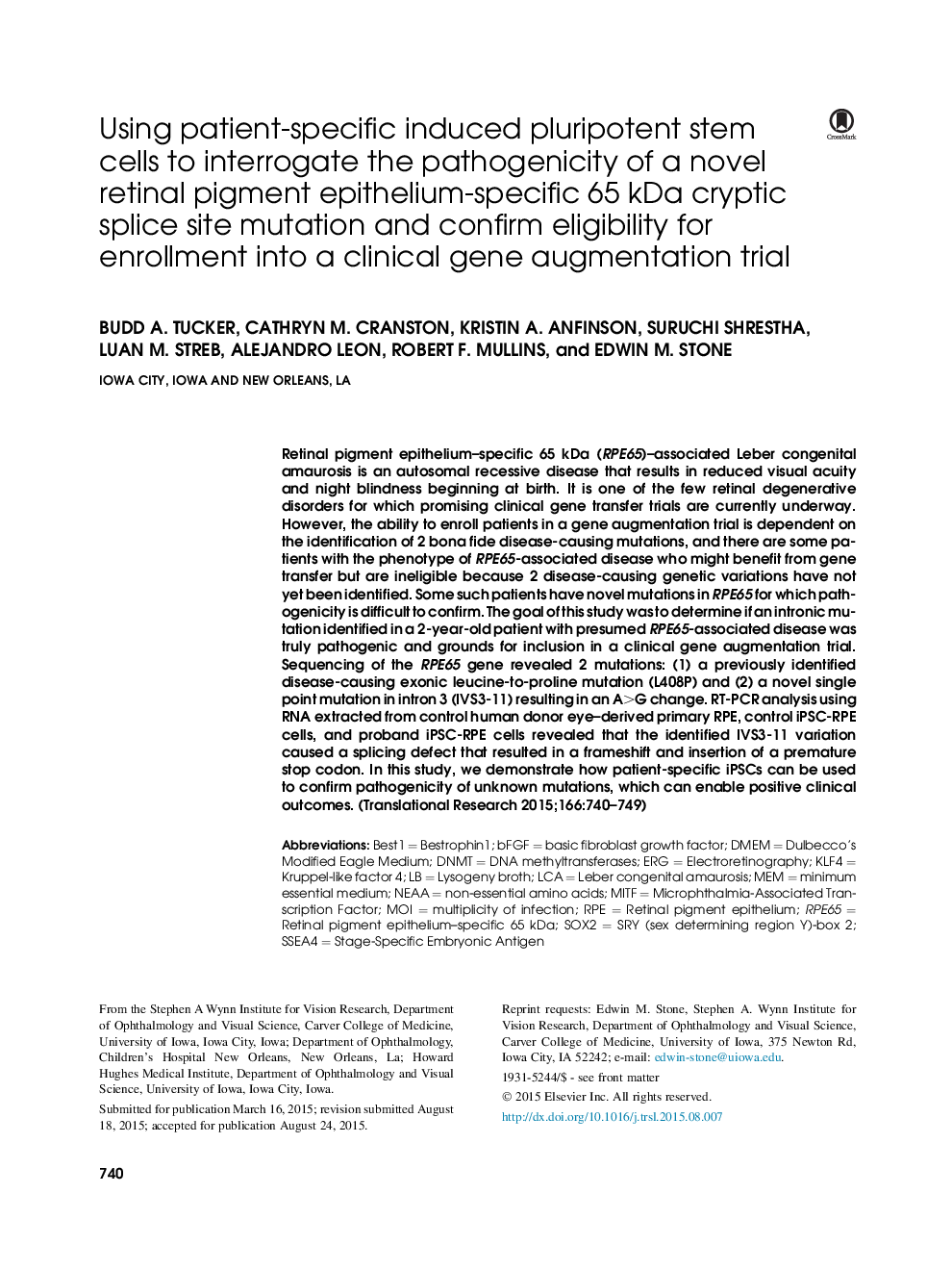| کد مقاله | کد نشریه | سال انتشار | مقاله انگلیسی | نسخه تمام متن |
|---|---|---|---|---|
| 3840112 | 1247889 | 2015 | 11 صفحه PDF | دانلود رایگان |
عنوان انگلیسی مقاله ISI
Using patient-specific induced pluripotent stem cells to interrogate the pathogenicity of a novel retinal pigment epithelium-specific 65Â kDa cryptic splice site mutation and confirm eligibility for enrollment into a clinical gene augmentation trial
دانلود مقاله + سفارش ترجمه
دانلود مقاله ISI انگلیسی
رایگان برای ایرانیان
کلمات کلیدی
DMEMSRY (sex determining region Y)-Box 2Stage-specific embryonic antigenNEAADNA methyltransferasesMITFBest1RPE65Sox2DnmtRPEKLF4ERGbFGFDulbecco's modified Eagle Medium - Eagle Medium اصلاح شده DulbeccoLeber congenital amaurosis - Leber Amaurosis مادرزادیMOI - MELCA - ارزیابی چرخه حیاتnon-essential amino acids - اسید آمینه غیر ضروریelectroretinography - الکتروترینگرافیretinal pigment epithelium - اپیتلیوم رنگدانه شبکیهminimum essential medium - حداقل حداقل مورد نیازKrüppel-like factor 4 - عامل کریپال مانند 4basic fibroblast growth factor - فاکتور رشد فیبروبلاست پایهMicrophthalmia-associated transcription factor - فاکتور رونویسی مرتبط با میکرو فتالمیlysogeny broth - لیزوزومی گوگردMEM - مامانmultiplicity of infection - چندین عفونت
موضوعات مرتبط
علوم پزشکی و سلامت
پزشکی و دندانپزشکی
پزشکی و دندانپزشکی (عمومی)
پیش نمایش صفحه اول مقاله

چکیده انگلیسی
Retinal pigment epithelium-specific 65Â kDa (RPE65)-associated Leber congenital amaurosis is an autosomal recessive disease that results in reduced visual acuity and night blindness beginning at birth. It is one of the few retinal degenerative disorders for which promising clinical gene transfer trials are currently underway. However, the ability to enroll patients in a gene augmentation trial is dependent on the identification of 2 bona fide disease-causing mutations, and there are some patients with the phenotype of RPE65-associated disease who might benefit from gene transfer but are ineligible because 2 disease-causing genetic variations have not yet been identified. Some such patients have novel mutations in RPE65 for which pathogenicity is difficult to confirm. The goal of this study was to determine if an intronic mutation identified in a 2-year-old patient with presumed RPE65-associated disease was truly pathogenic and grounds for inclusion in a clinical gene augmentation trial. Sequencing of the RPE65 gene revealed 2 mutations: (1) a previously identified disease-causing exonic leucine-to-proline mutation (L408P) and (2) a novel single point mutation in intron 3 (IVS3-11) resulting in an A>G change. RT-PCR analysis using RNA extracted from control human donor eye-derived primary RPE, control iPSC-RPE cells, and proband iPSC-RPE cells revealed that the identified IVS3-11 variation caused a splicing defect that resulted in a frameshift and insertion of a premature stop codon. In this study, we demonstrate how patient-specific iPSCs can be used to confirm pathogenicity of unknown mutations, which can enable positive clinical outcomes.
ناشر
Database: Elsevier - ScienceDirect (ساینس دایرکت)
Journal: Translational Research - Volume 166, Issue 6, December 2015, Pages 740-749.e1
Journal: Translational Research - Volume 166, Issue 6, December 2015, Pages 740-749.e1
نویسندگان
Budd A. Tucker, Cathryn M. Cranston, Kristin A. Anfinson, Suruchi Shrestha, Luan M. Streb, Alejandro Leon, Robert F. Mullins, Edwin M. Stone,